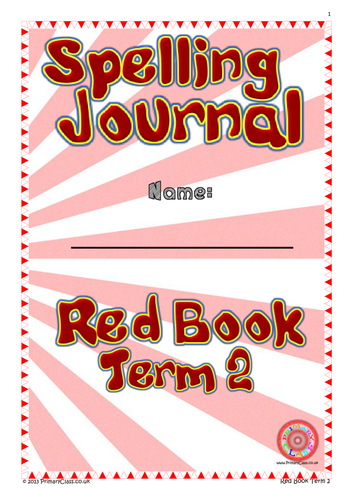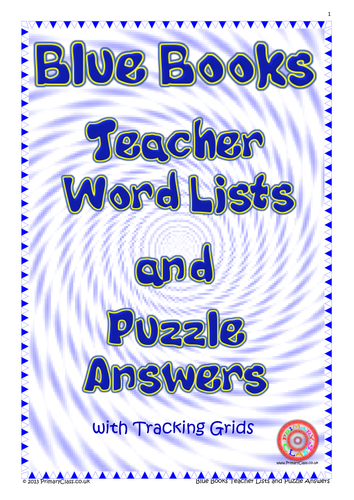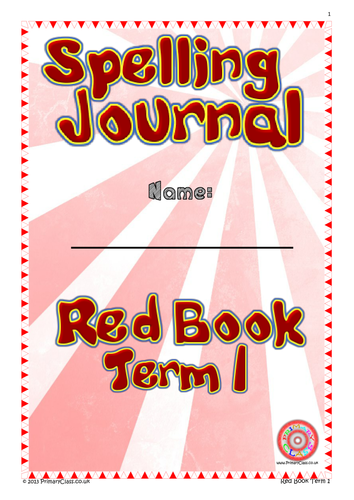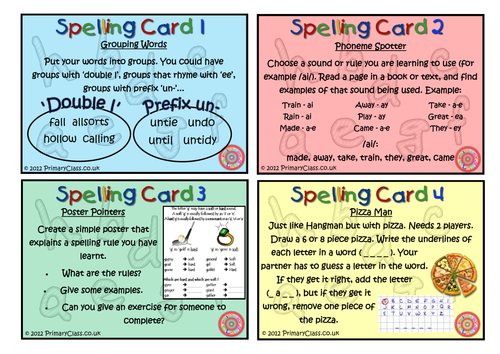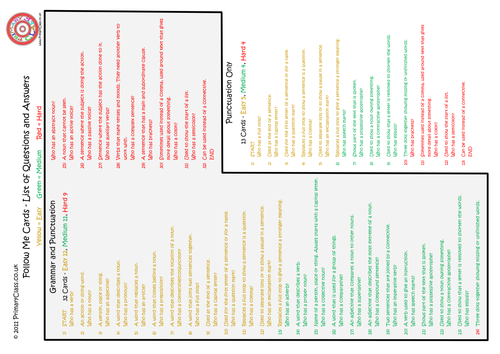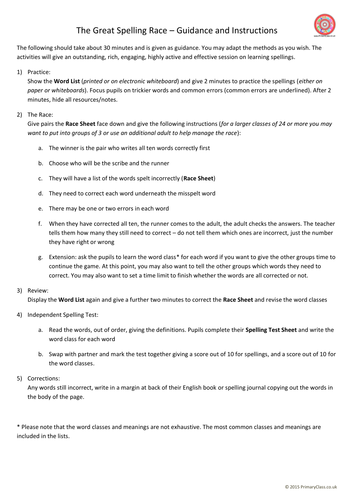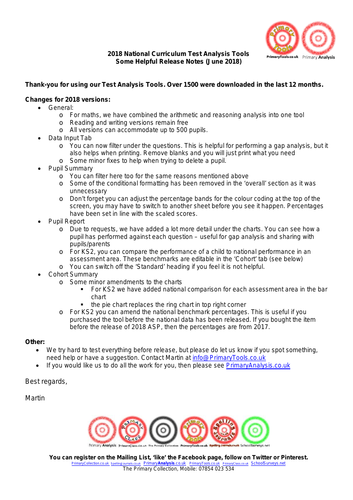
284Uploads
2081k+Views
2046k+Downloads
English

Spelling Journal - Green Book Term 3 - Year 1 (Age 5/6) National Curriculum 2014
Term 3 of 3
Based on the Primary Curriculum for English 2014. Separated into 10 weeks, 10 words per week. Each week includes themed word list, practice space, word search and anagrams. Notes and contents page also included as are rule explanations as appropriate. Printing as a booklet recommended to produce an A5 size book. Requires a pdf reader
Other levels and teacher books available: https://www.tes.com/teaching-resources/shop/primaryclass

Spelling Journal - Red Book Term 2 - Year 3/4 (Age 7-9) National Curriculum 2014
Spelling Journal - Red Book Term 2 - Year 3/4 (Age 7-9) National Curriculum 2014
Term 2 of 3
Based on the Primary Curriculum for English 2014. Separated into 10 weeks, 10 words per week. Each week includes themed word list, practice space, word search and anagrams. Notes and contents page also included as are rule explanations as appropriate. Printing as a booklet recommended to produce an A5 size book. Requires a pdf reader
Other levels and teacher books available: https://www.tes.com/teaching-resources/shop/primaryclass

Spelling Journals - Blue Set - Year 2 - Teacher Book
Blue set (Year 2) Teacher Book - Term 1 to 3 Teacher Spelling Lists, Tracking Grids and Puzzle Answers
Requires a pdf reader.
Other levels and teacher books available: https://www.tes.com/teaching-resources/shop/primaryclass

Spelling Journal - Green Book Term 2 - Year 1 (Age 5/6) National Curriculum 2014
Term 2 of 3
Based on the Primary Curriculum for English 2014. Separated into 10 weeks, 10 words per week. Each week includes themed word list, practice space, word search and anagrams. Notes and contents page also included as are rule explanations as appropriate. Printing as a booklet recommended to produce an A5 size book. Requires a pdf reader

Spelling Journal - Red Book Term 1 - Year 3/4 (Age 7-9) National Curriculum 2014
Spelling Journal - Red Book Term 1 - Year 3/4 (Age 7-9) National Curriculum 2014
Term 1 of 3
Based on the Primary Curriculum for English 2014. Separated into 10 weeks, 10 words per week. Each week includes themed word list, practice space, word search and anagrams. Notes and contents page also included as are rule explanations as appropriate. Printing as a booklet recommended to produce an A5 size book. Requires a pdf reader
Other levels and teacher books available: https://www.tes.com/teaching-resources/shop/primaryclass

Spelling Strategy Cards
Designed to help pupils independently learn spellings. A set of 24 cards with a variety of strategies in the form of games and activities.
Sample found here: https://www.tes.com/teaching-resource/spelling-strategy-cards-for-pupils-6293030

2018 KS2 Writing Electronic Analysis Tool With new enhanced pupil reporting
This is a new tool intended to help leaders, teachers, children and parents organise, inform and
plan for future learning. Due to the complexity of the current assessment system (and if you are
used to using the PrimaryTools Tests Analysis Tools), there are a few things to be aware of using
this tool.
Firstly, if you are confident a pupil has already met the Working Towards criteria (W/T),
we recommend filling in the '1s' on the data input tab for Working Towards rather than leave them
blank (not assessed), and likewise for those working at a Greater Depth (G/D). Most children will
be working within and towards the Expected standard, and this tool focuses on them. Many of the
tables and charts will only be based on the Expected Criteria (the headings will make this clear).
We cannot stress enough that this should be used in conjunction with the Frameworks. The
criteria have been derived from them as closely as possible, but do not match exactly with them.
Criteria starting with 'e.g.' are examples and not necessarily required to meet the expected
standard, however this tool will treat those criteria as required. Use this as a tool to inform and
read the frameworks!
We hope you will like the enhanced Pupil Reports. There is a second page with a thorough
break down of what a pupil needs to focus on. Send us an email if there is something you
are not sure of, we would very much love your feedback too! info@primarytools.co.uk.

57 Grammar, Punctuation, Vocabulary and Spelling Terminology Posters
This 57 poster set is based on the terminology used both in the 2012 Grammar, Punctuation and Vocabulary sample tests for Year 6 (released in December 2012), and the terminology used in the Primary Draft Curriculum for English (2012). Each poster has the terminology as a heading followed by a brief description and example. Colour coded for terminology type. Aimed at KS2.
Sample found here: https://www.tes.com/teaching-resource/grammar-punctuation-vocabulary-terminology-posters-6312198

Grammar and Punctuation 'Follow Me' Game
Includes 3 colour coded levels
Free punctuation only version: https://www.tes.com/teaching-resource/punctuation-follow-me-loop-card-game-quiz-6111575

2016 KS2 Grammar, Punctuation and Spelling Test Electronic Analysis
Produces easy on the eye tables and charts for cohorts and individuals. Broken down into areas of learning and specific question performance.
Electronic Analysis with individual pupil reporting for up to 550 pupils
(works best in Excel 2010 or later with macros enabled)
Full free 2016 KS2 Reading Analysis Tool available here:
https://www.tes.com/teaching-resource/2016-ks2-test-electronic-analysis-for-reading-11291700
2016 Mathematics Version also available:
https://www.tes.com/teaching-resource/2016-ks2-test-electronic-analysis-for-mathematics-11291695

The Great Spelling Race
Fast and fun - outstanding, rich, engaging, highly active and effective races on commonly misspelt words.
Ideal for quick booster sessions.
10x 30 minute races for a whole class with minimal preparation.
Includes instructions, race sheets, word lists and test sheets.
Free sample here: https://www.tes.com/teaching-resource/the-great-spelling-race-11040895

2018 Phonics Check Question Level Analysis
Summary of Features:
Pupil Summary shows total marks for each paper, number of questions unanswered, number of incorrect answers, total overall score (and percent), total score in each focus area. Option to adjust the colour thresholds to make it easier to spot patterns and gaps.
Pupil Reports show a summary of performance in each focus area for an individual pupil. Useful for feeding back to pupils, parents and informing intervention teachers.
Cohort Summary shows an overview of the cohort against each focus area. This page gives a summary of attainment including number and percent meeting the expected standard.
Other Charts Charts which show performance for each question, organised by most correct to incorrect and by word type.
Requires Excel with macros enabled.

2017 Phonics Check Question Level Analysis
Summary of Features:
Pupil Summary shows total marks for each paper, number of questions unanswered, number of incorrect answers, total overall score (and percent), total score in each focus area. Option to adjust the colour thresholds to make it easier to spot patterns and gaps.
Pupil Reports show a summary of performance in each focus area for an individual pupil. Useful for feeding back to pupils, parents and informing intervention teachers.
Cohort Summary shows an overview of the cohort against each focus area. This page gives a summary of attainment including number and percent meeting the expected standard.
Other Charts Charts which show performance for each question, organised by most correct to incorrect and by word type.
Requires Excel with macros enabled.

2024 Phonics Check Question Level Analysis
Summary of Features:
Pupil Summary shows total marks for each paper, number of questions unanswered, number of incorrect answers, total overall score (and percent), total score in each focus area. Option to adjust the colour thresholds to make it easier to spot patterns and gaps.
Pupil Reports show a summary of performance in each focus area for an individual pupil. Useful for feeding back to pupils, parents and informing intervention teachers.
Contextual Analysis (2019 versions onwards) shows a breakdown by key groups (gender, SEND status, disadvantaged, EAL) plus up to four custom groups. Compares school data (grades and scaled scores) to national data in a detailed but user-friendly report.
Cohort Summary shows an overview of the cohort against each focus area. This page gives a summary of attainment including number and percent meeting the expected standard.
Other Charts Charts which show performance for each question, organised by most correct to incorrect and by word type.

2022 Phonics Check Question Level Analysis
Summary of Features:
Pupil Summary shows total marks for each paper, number of questions unanswered, number of incorrect answers, total overall score (and percent), total score in each focus area. Option to adjust the colour thresholds to make it easier to spot patterns and gaps.
Pupil Reports show a summary of performance in each focus area for an individual pupil. Useful for feeding back to pupils, parents and informing intervention teachers.
Cohort Summary shows an overview of the cohort against each focus area. This page gives a summary of attainment including number and percent meeting the expected standard.
Other Charts Charts which show performance for each question, organised by most correct to incorrect and by word type.
Requires Excel with macros enabled.

2019 Phonics Check Question Level Analysis
Summary of Features:
Pupil Summary shows total marks for each paper, number of questions unanswered, number of incorrect answers, total overall score (and percent), total score in each focus area. Option to adjust the colour thresholds to make it easier to spot patterns and gaps.
Pupil Reports show a summary of performance in each focus area for an individual pupil. Useful for feeding back to pupils, parents and informing intervention teachers.
Cohort Summary shows an overview of the cohort against each focus area. This page gives a summary of attainment including number and percent meeting the expected standard.
Other Charts Charts which show performance for each question, organised by most correct to incorrect and by word type.
Requires Excel with macros enabled.

2024 KS1 Grammar, Punctuation & Spelling Test and Question Level Analysis
2024 KS1 Grammar, Punctuation & Spelling Test and Question Level Analysis
Requires Excel with macros enabled.
Instant download after purchase. Maximum of 5 downloads.
Please note sample pictures are for the KS2 Mathematics Analysis.
Summary of Features (please note some features may not be available depending on the test type):
Pupil Summary shows total marks for each paper, number of questions unanswered (possibly indicating need to increase pace), number of incorrect answers, total overall score (and percent), total score in each strand. Option to adjust the colour thresholds to make it easier to spot patterns and gaps.
Pupil Reports show a summary of performance in each strand for an individual pupils. Available in 2016 versions and later. Contain detailed feedback on each question. Useful for feeding back to pupils, parents and informing intervention teachers.
Contextual Analysis (2016 versions onwards) shows a breakdown by key groups (gender, SEND status, disadvantaged, EAL) plus up to four custom groups. Compares school data (grades and scaled scores) to national data in a detailed but user-friendly report.
Cohort Summary shows an overview of the cohort against each strand. This is also compared to national data where it is available. This page gives a summary of attainment including number and percent at expected and higher standard.
Strand Summary shows a the weighting of each strand and the performance within it. For example, in a grammar test a cohort may perform poorly in identifying sentence types and equally poorly in identifying punctuation. However as there is more weighting given to punctuation, it would be advisable to focus on this area.
Other Charts Charts which show performance for each question, organised by most correct to incorrect, by strand and also by year group question (for mathematics). The most powerful chart orders questions from most correct to incorrect enabling you to see precisely where there are strengths and weaknesses.
2024 KS1 Grammar, Punctuation & Spelling Test and Question Level Analysis (SATs)

2023 KS1 SATs Grammar, Punctuation and Spelling Test and Question Level Analysis
2023 KS1 Grammar, Punctuation and Spelling Test and Question Level Analysis
Requires Excel with macros enabled.
Summary of Features (please note some features may not be available depending on the test type):
Pupil Summary shows total marks for each paper, number of questions unanswered (possibly indicating need to increase pace), number of incorrect answers, total overall score (and percent), total score in each strand. Option to adjust the colour thresholds to make it easier to spot patterns and gaps.
Pupil Reports show a summary of performance in each strand for an individual pupils. Useful for feeding back to pupils, parents and informing intervention teachers.
Contextual Analysis shows a breakdown by key groups (gender, SEND status, disadvantaged, EAL) plus up to four custom groups. Compares school data (grades and scaled scores) to national data in a detailed but user-friendly report.
Cohort Summary shows an overview of the cohort against each strand. This is also compared to national data where it is available. This page gives a summary of attainment including number and percent at expected and higher standard.
Strand Summary shows a the weighting of each strand and the performance within it. For example, in a grammar test a cohort may perform poorly in identifying sentence types and equally poorly in identifying punctuation. However as there is more weighting given to punctuation, it would be advisable to focus on this area.
Other Charts Charts which show performance for each question, organised by most correct to incorrect, by strand and also by year group question (for mathematics). The most powerful chart orders questions from most correct to incorrect enabling you to see precisely where there are strengths and weaknesses.

2018 KS1 National Curriculum (SATs) Test Analysis for Grammar, Punctuation and Spelling.
2018 KS1 National Curriculum (SATs) Test Analysis for Grammar, Punctuation and Spelling.
Please see release notes for new features.
Analysis for all tests is available elsewhere on TES or from our website.

2019 KS1 Mathematics Question Level Analysis
Summary of Features (please note some features may not be available depending on the test type):
Pupil Summary shows total marks for each paper, number of questions unanswered (possibly indicating need to increase pace), number of incorrect answers, total overall score (and percent), total score in each strand. Option to adjust the colour thresholds to make it easier to spot patterns and gaps.
Pupil Reports show a summary of performance in each strand for an individual pupils. Available in 2017 versions and later excluding reading. 2018 versions and later contain detailed feedback on each question. Useful for feeding back to pupils, parents and informing intervention teachers.
Cohort Summary shows an overview of the cohort against each strand. This is also compared to national data where it is available. This page gives a summary of attainment including number and percent at expected and higher standard.
Strand Summary shows a the weighting of each strand and the performance within it. For example, in a grammar test a cohort may perform poorly in identifying sentence types and equally poorly in identifying punctuation. However as there is more weighting given to punctuation, it would be advisable to focus on this area.
Other Charts Charts which show performance for each question, organised by most correct to incorrect, by strand and also by year group question (for mathematics). The most powerful chart orders questions from most correct to incorrect enabling you to see precisely where there are strengths and weaknesses.


